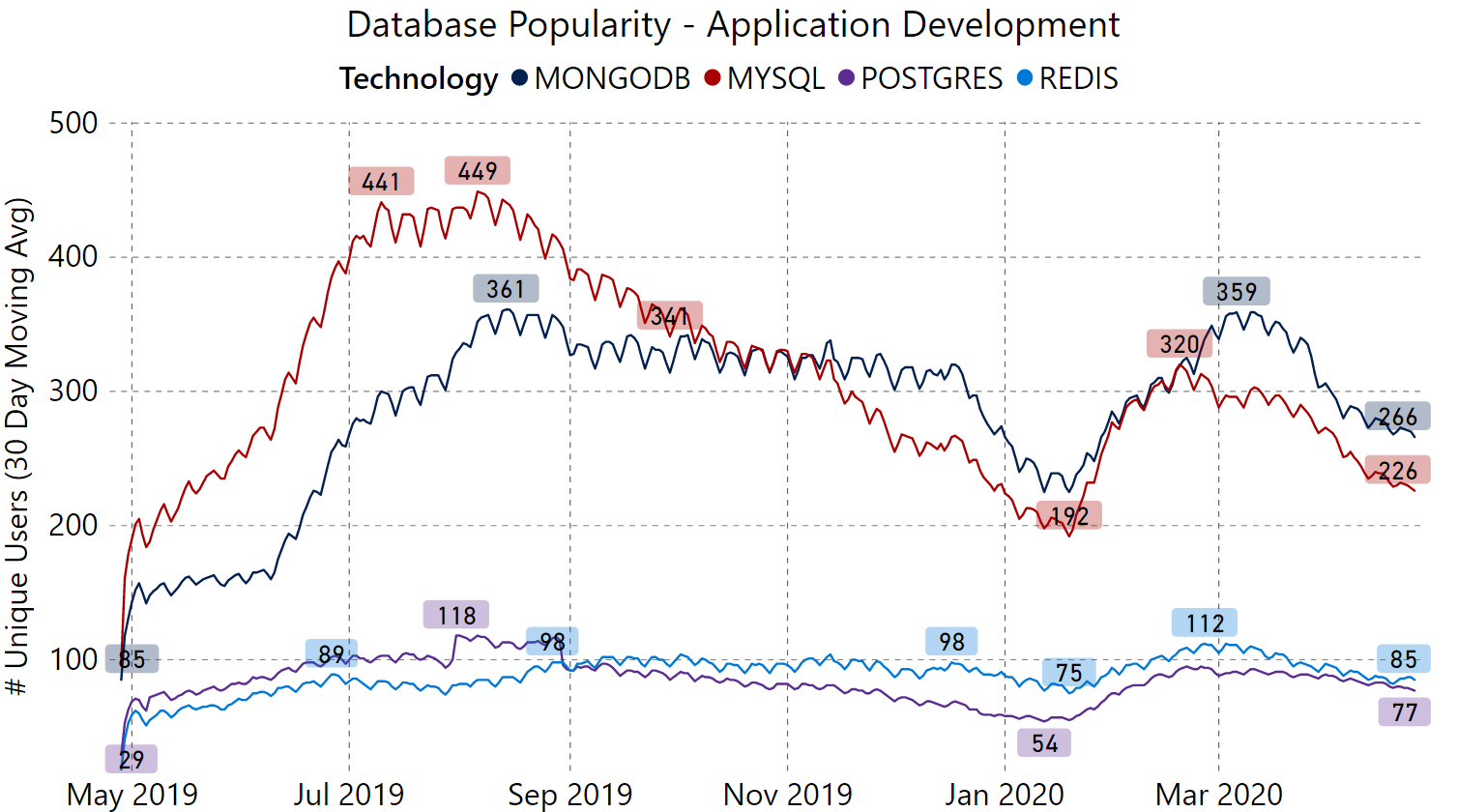In part 1 of this series, we investigated the popularity of 5 ODMS solutions using Aberdeen Behavioral technographics and concluded that MySQL reigned supreme. That examination was an aggregate view over the past 365 days, and simply confirmed previous research on the topic.
Although valuable, an aggregate view often misrepresents underlying dynamics. For example, MySQL is the most popular, but is its popularity increasing or decreasing relative to other databases? If the popularity dynamic is changing, what are the underlying causes?
In part 2 of this series we will examine these questions and dive into some of the underlying dynamics that may be at play.
Popularity Over Time
MySQL was and remains the most popular at the aggregate level when evaluating activity over time (Figure 1). With a range of 2,700 to 5,500 unique users (30 Day Moving Average), it far outstrips the second most popular.
Figure 1
What is most noteworthy is the convergence in user activity between PostgreSQL and MongoDB beginning in mid to late November 2019 (highlight the area on the chart). The number of active users (30 Day Moving Average) is roughly equal between the two databases, standing at approximately 1000, as of late April (Figure 2).
Figure 2

Interestingly, these MongoDB users are reading more articles than PostgreSQL users during this time frame — roughly 1.3 to 1.9X as many (Figure 3). This is a clear indication that the dynamic between these two solutions is changing, with MongoDB becoming more popular than PostgreSQL.
Figure 3

Application Development – A Changing Dynamic and the Rise of MongoDB
What could explain this apparent rise in popularity? To answer this question, we will have to dive into some of the underlying topical areas that underpin these solutions. Focusing on the area of notable importance over the past decade — application development — we segment the data for articles that include references of different application frameworks, libraries, development techniques, containerization, and run-time environments (Table 1).
Table 1 – Application Development Topics
| Topic | Description |
|---|---|
| Django | Framework |
| ASP.NET | Framework |
| Express.js | Framework |
| Node.js | Run-time Environment |
| Flask | Framework |
| Laravel | Framework |
| Pyjs | Framework |
| Pyramid | Framework |
| React.js | Library |
| Ruby on Rails | Framework |
| Spring Boot | Framework |
| AJAX | Development Technique |
| Docker | Containerization |
| Kubernetes | Container Orchestration |
MongoDB openly touts that it is “the most popular database for modern applications,” and Aberdeen’s behavioral technographic data confirms this statement.
When viewed within the context of application development, the dynamics of the market shift dramatically. MongoDB has become the most popular database overall — far surpassing PostgreSQL (which actually falls behind Redis), and even overtaking MySQL (Figure 4). This rise is driven primarily by activity on articles regarding Spring Boot and Node.js, with MongoDB receiving a combined 37,000 more page views than MySQL from November 2019 to April 2020 (Figure 5).
Figure 4

Figure 5

The Cloud Era – Partnerships are a Plus
In Part 1 of this blog series, we briefly touched upon how the growth in the cloud market has continued to enable open source systems. The push by MongoDB to be “the database for modern application development and the cloud era” exemplifies this. Our data shows a notable rise in popularity following the announced partnership with Google Cloud and their acquisition of Realm, a popular mobile database and data synchronization technology in April of 2019.
In part 3 of this series we will dive ever deeper into the underlying topical areas and evaluate the “content demand” surrounding these different OSDBMS solutions.



